Teaching and learning legal English in businessrelated majors: Advantages and disadvantagesx
This paper is composed specifically to point out the pros and cons of Legal English learning
and teaching in universities which includes business-related subjects in their curricula. The
methodology employed is qualitative method, conducted through collecting and analysing
secondary data in combination with observations and experimentation in daily classroom
activities. It has been found out that, besides such advantages as learners’ English fluency, both
practical and theoretical material diversity and up-to-date curricula in business-related
universities, lack of materials for learning, time-consuming preparation and insufficient passion
are among many issues to be addressed in teaching and learning Legal English in universities.
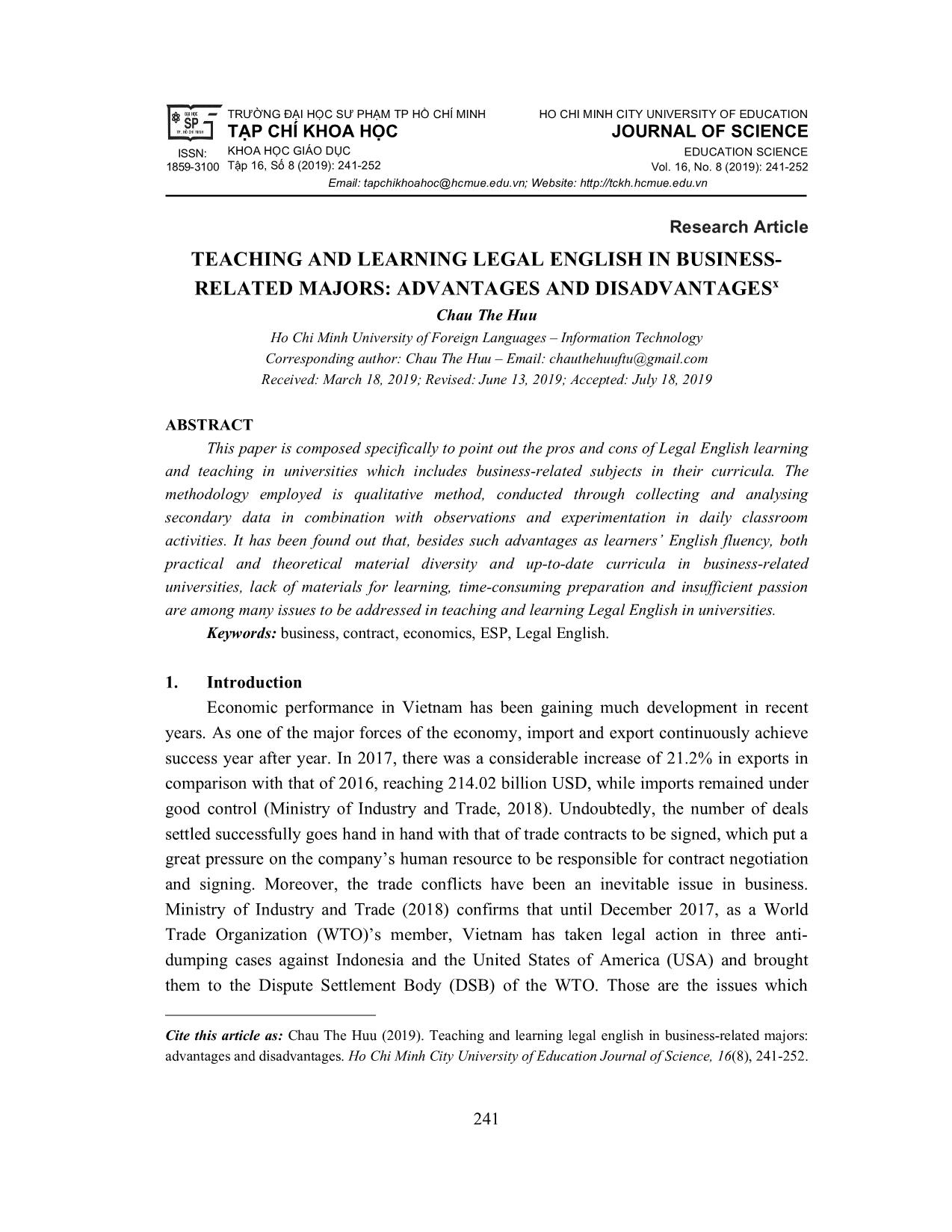
Trang 1
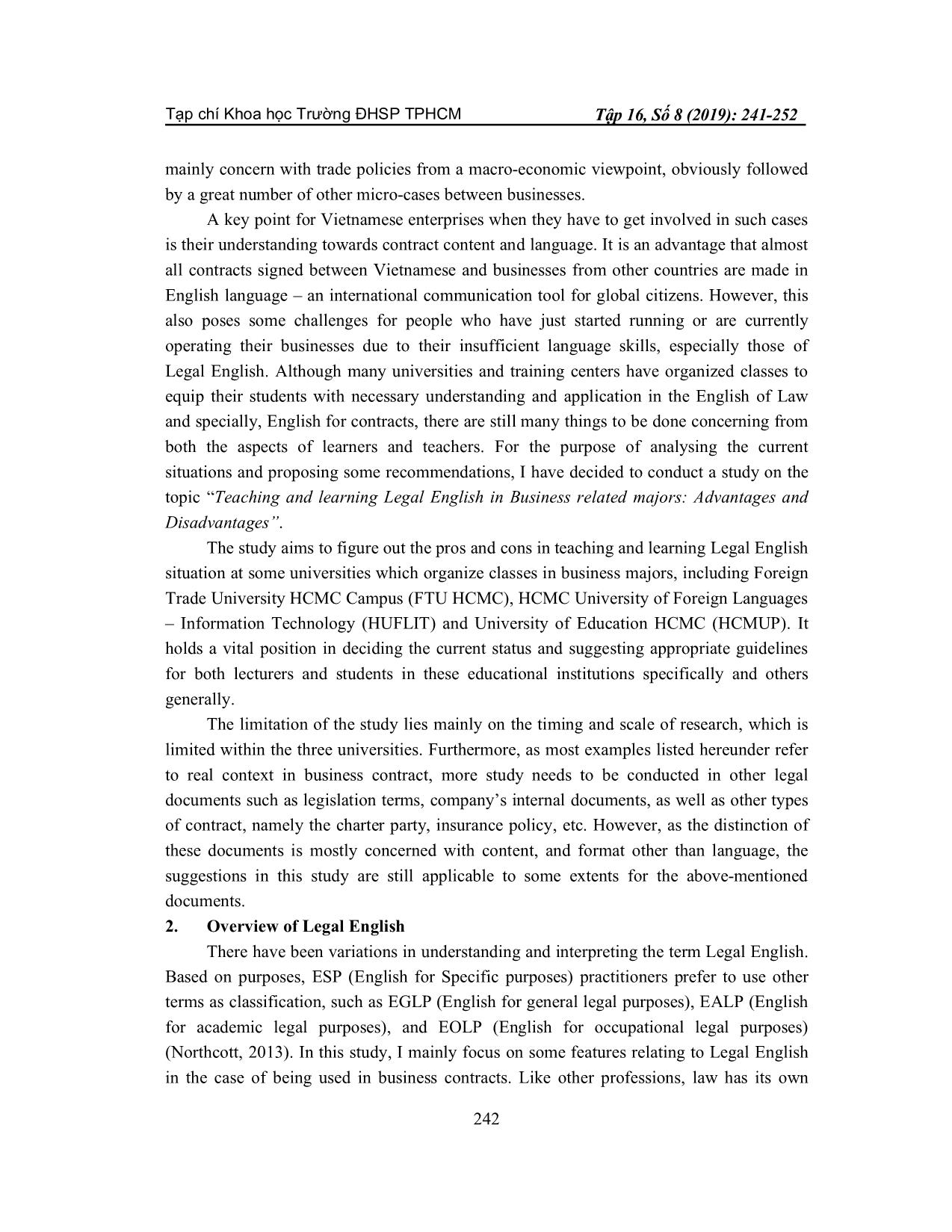
Trang 2
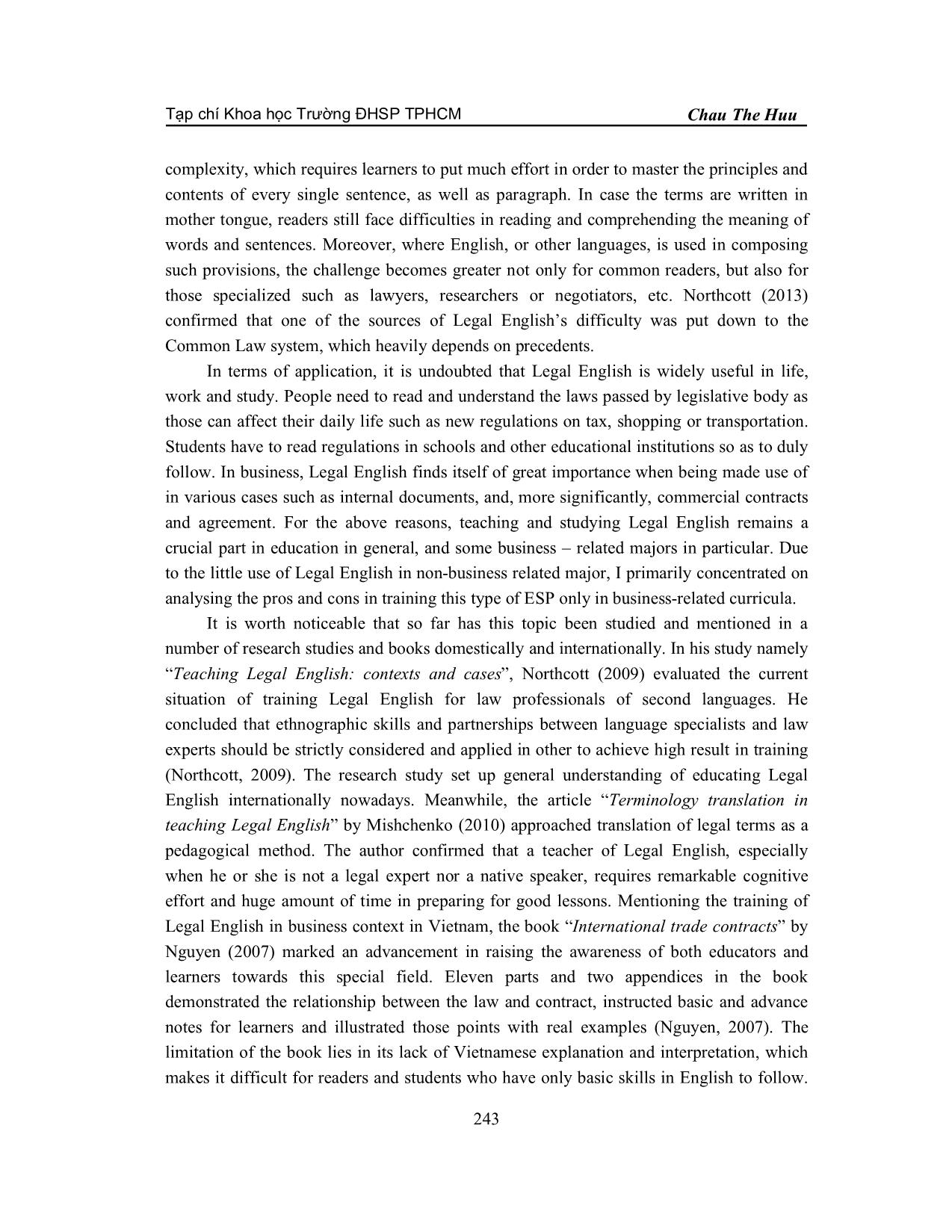
Trang 3
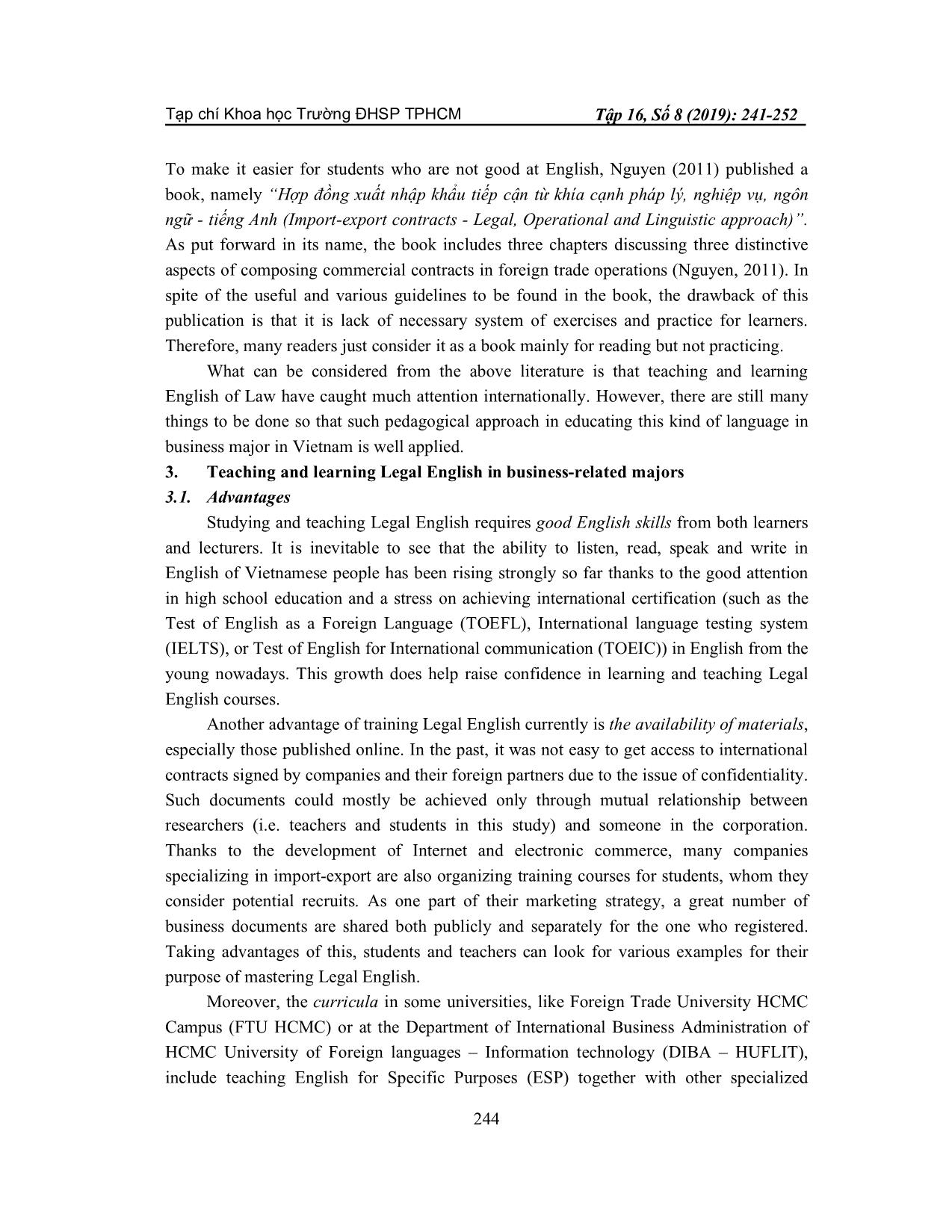
Trang 4
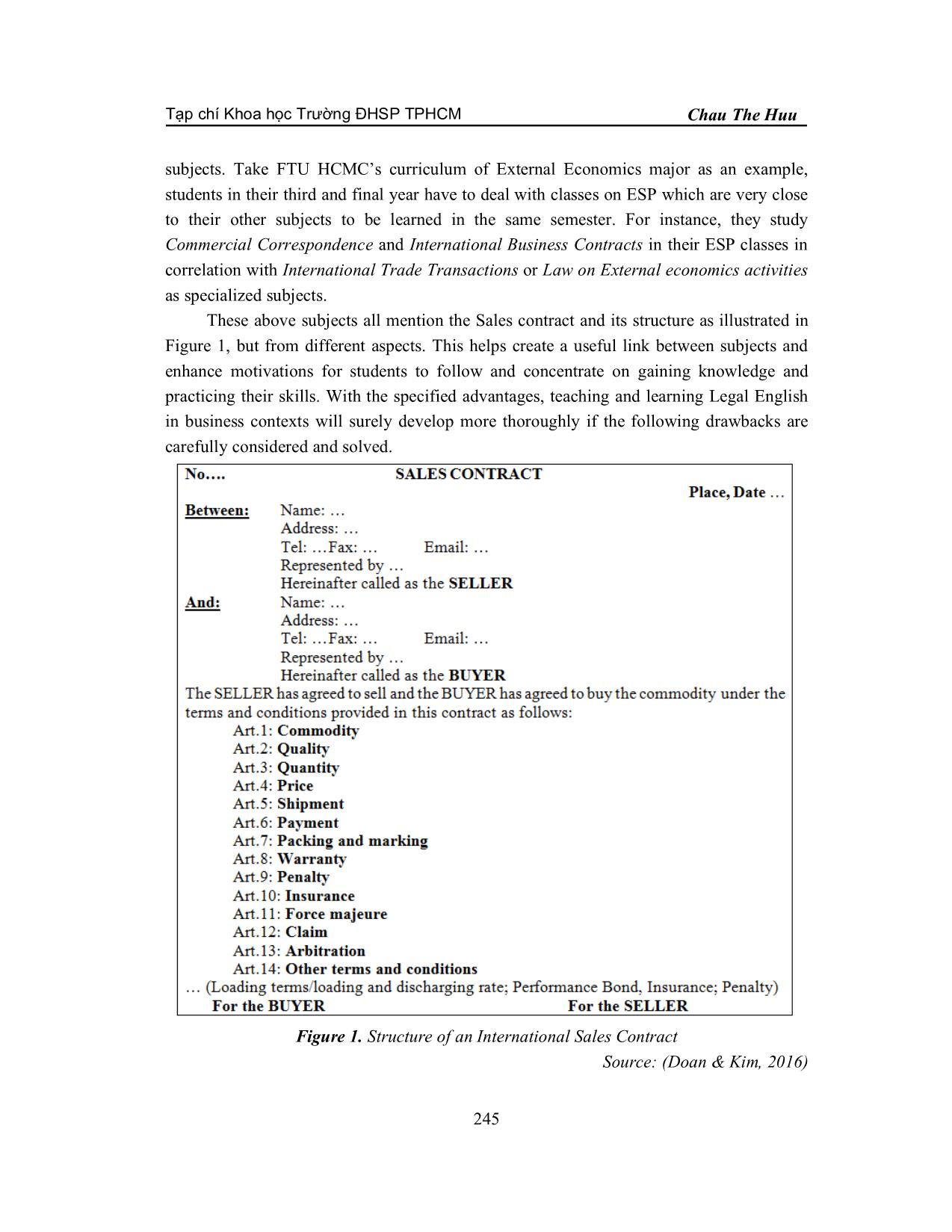
Trang 5
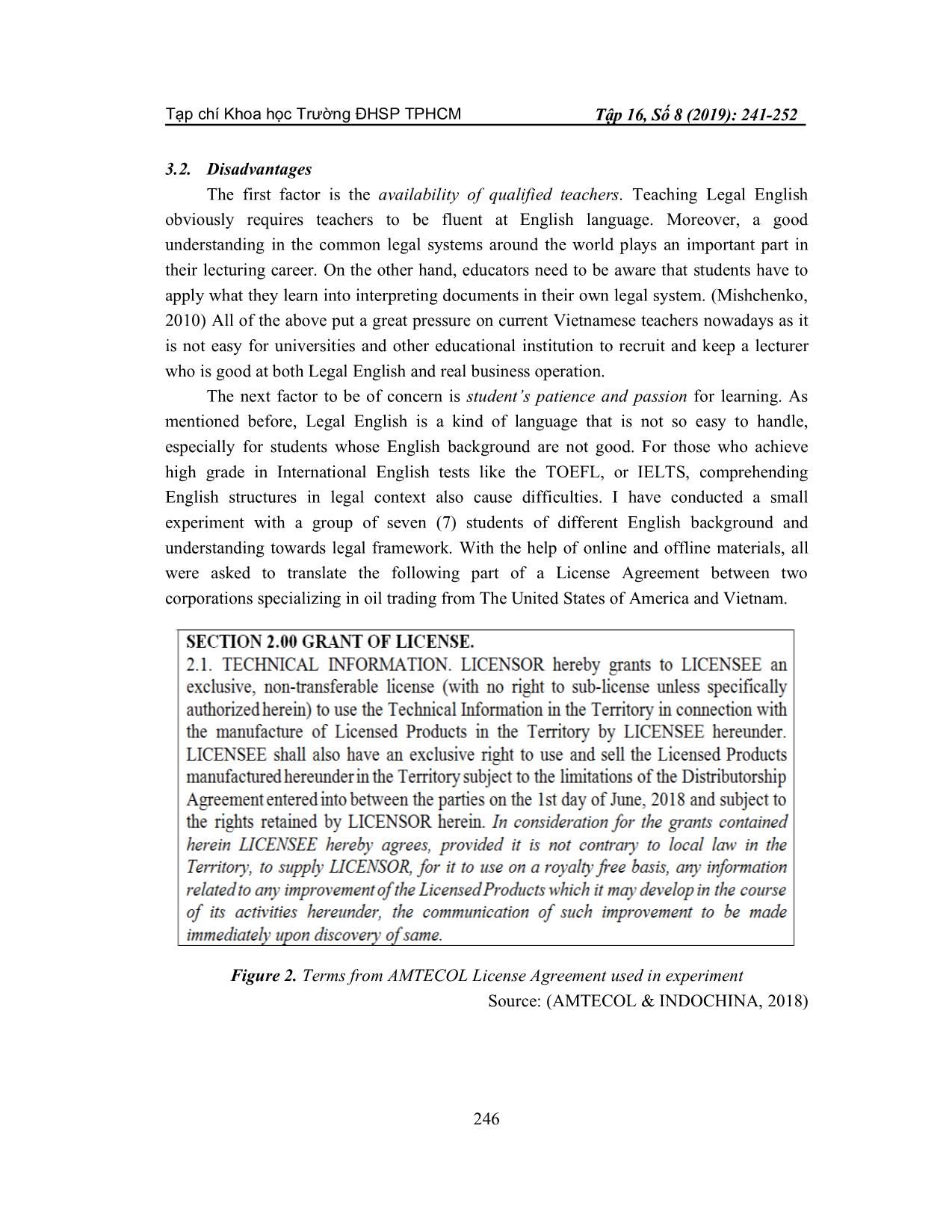
Trang 6
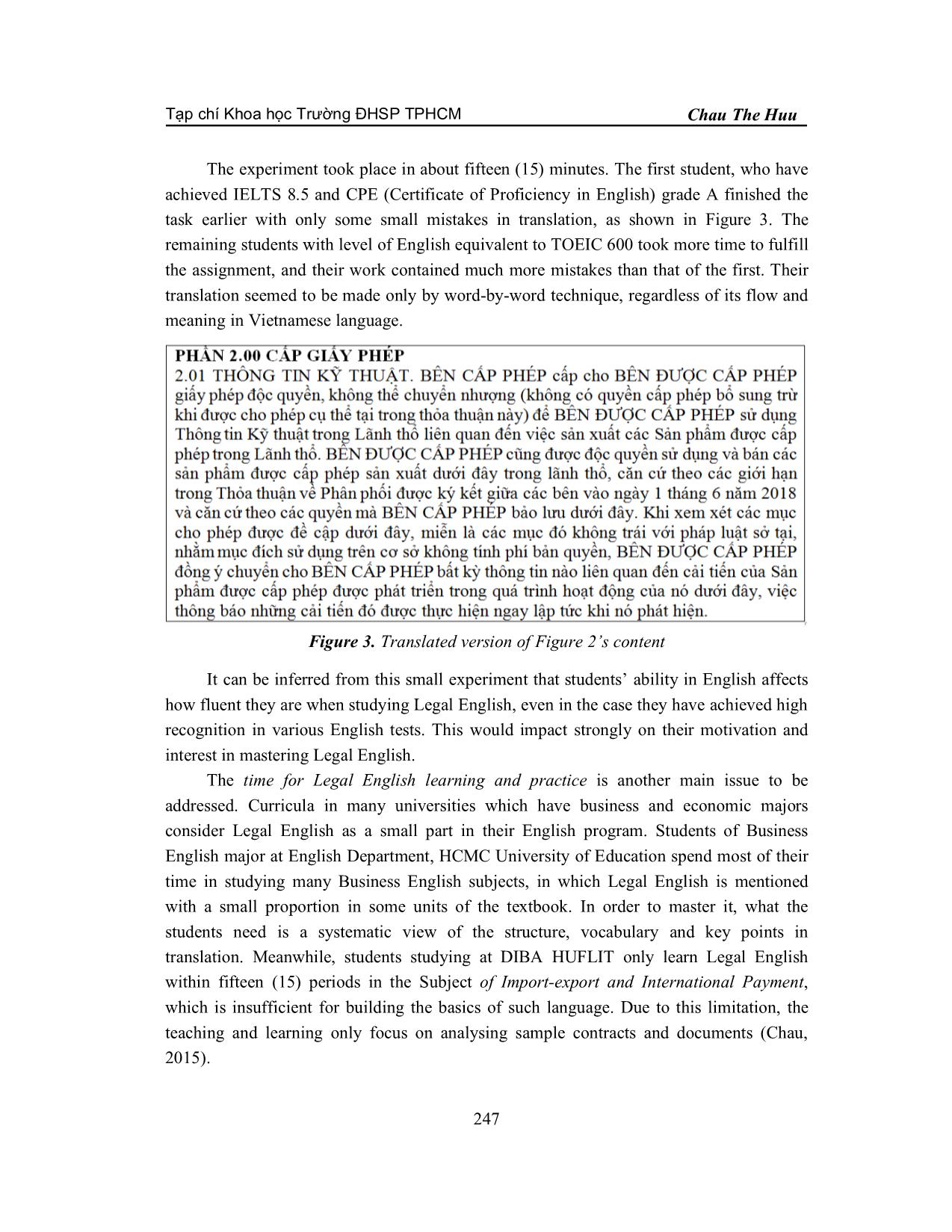
Trang 7
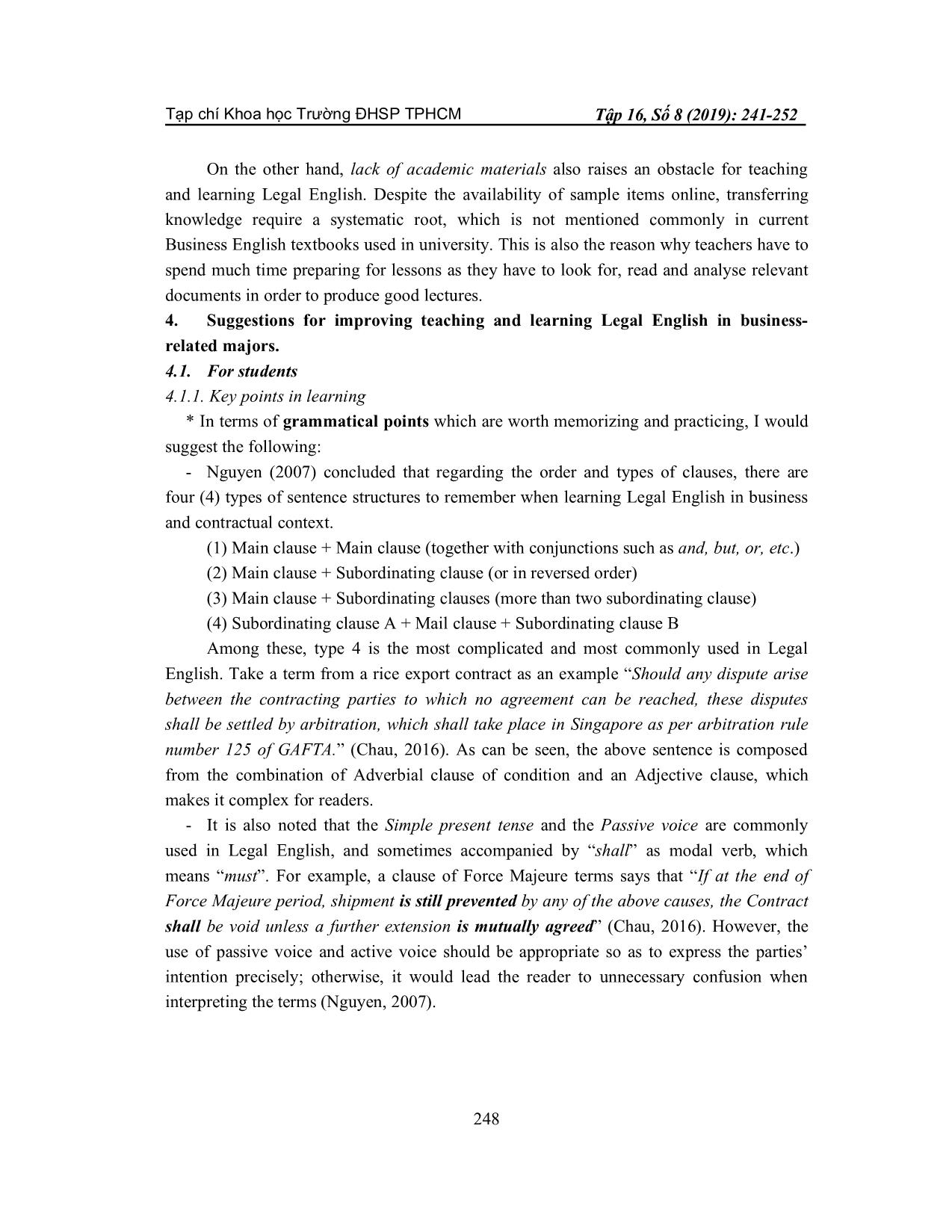
Trang 8
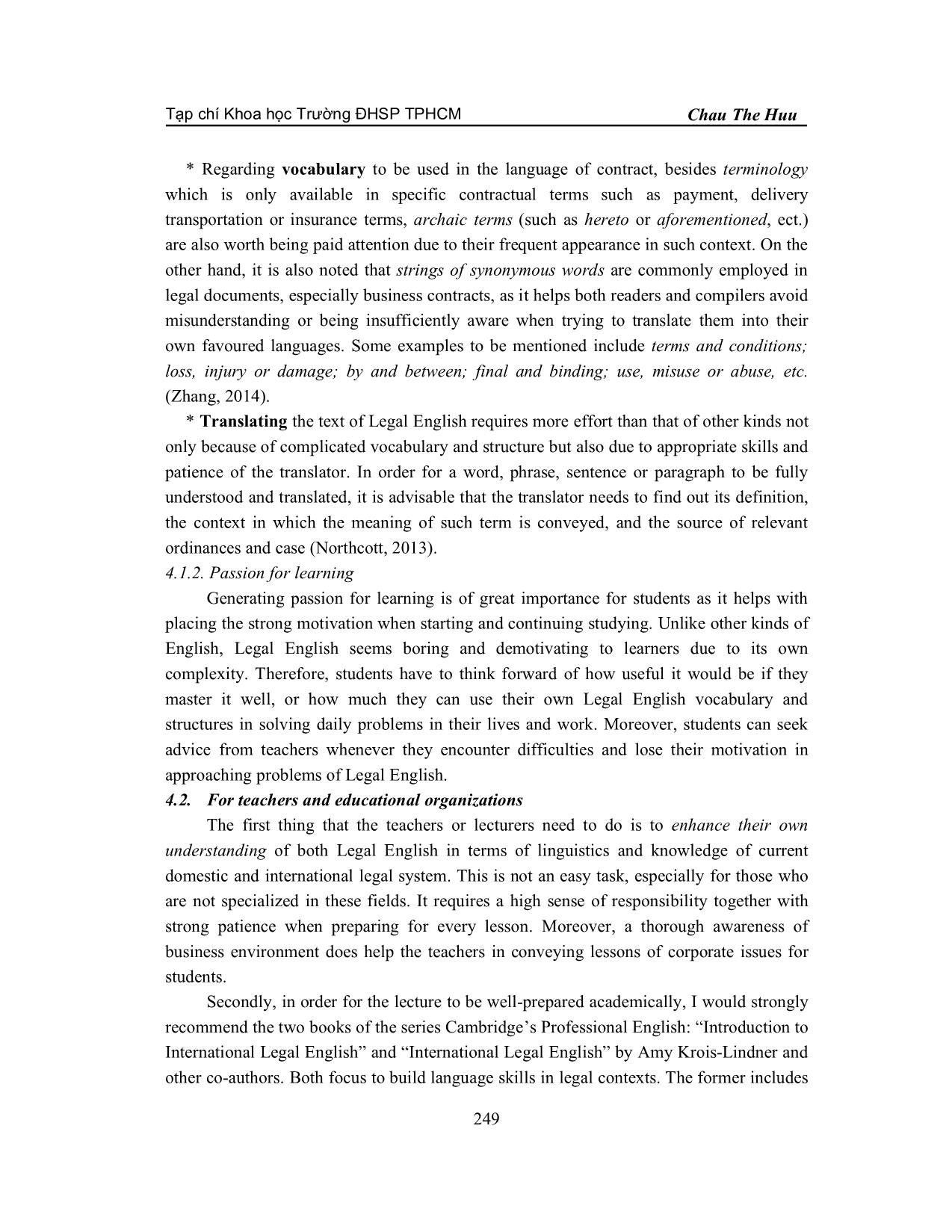
Trang 9
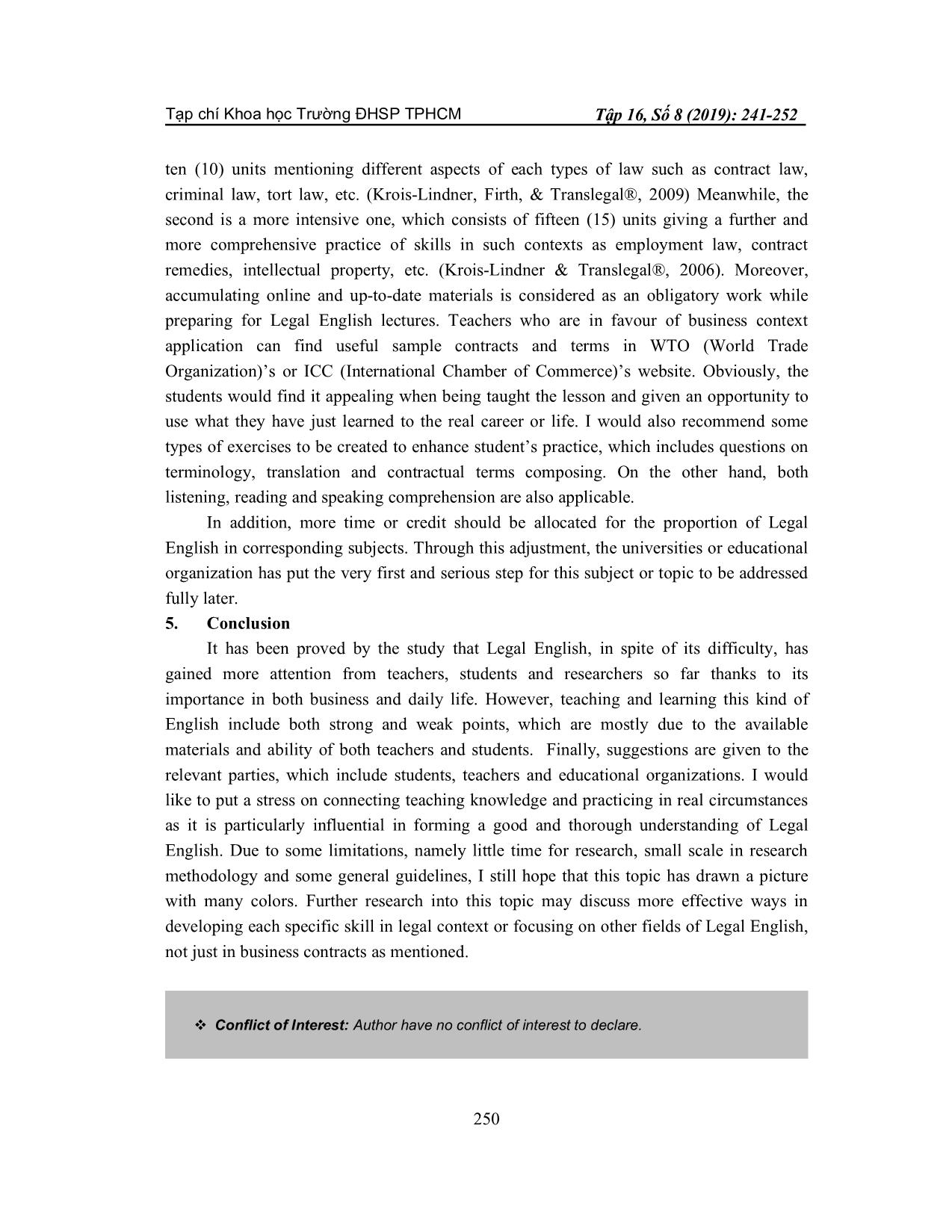
Trang 10
Tải về để xem bản đầy đủ
Tóm tắt nội dung tài liệu: Teaching and learning legal English in businessrelated majors: Advantages and disadvantagesx
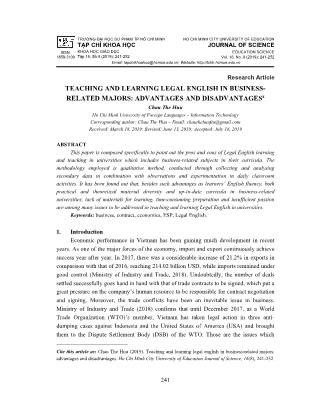
ring career. On the other hand, educators need to be aware that students have to apply what they learn into interpreting documents in their own legal system. (Mishchenko, 2010) All of the above put a great pressure on current Vietnamese teachers nowadays as it is not easy for universities and other educational institution to recruit and keep a lecturer who is good at both Legal English and real business operation. The next factor to be of concern is student’s patience and passion for learning. As mentioned before, Legal English is a kind of language that is not so easy to handle, especially for students whose English background are not good. For those who achieve high grade in International English tests like the TOEFL, or IELTS, comprehending English structures in legal context also cause difficulties. I have conducted a small experiment with a group of seven (7) students of different English background and understanding towards legal framework. With the help of online and offline materials, all were asked to translate the following part of a License Agreement between two corporations specializing in oil trading from The United States of America and Vietnam. Figure 2. Terms from AMTECOL License Agreement used in experiment Source: (AMTECOL & INDOCHINA, 2018) Tạp chí Khoa học Trường ĐHSP TPHCM Chau The Huu 247 The experiment took place in about fifteen (15) minutes. The first student, who have achieved IELTS 8.5 and CPE (Certificate of Proficiency in English) grade A finished the task earlier with only some small mistakes in translation, as shown in Figure 3. The remaining students with level of English equivalent to TOEIC 600 took more time to fulfill the assignment, and their work contained much more mistakes than that of the first. Their translation seemed to be made only by word-by-word technique, regardless of its flow and meaning in Vietnamese language. Figure 3. Translated version of Figure 2’s content It can be inferred from this small experiment that students’ ability in English affects how fluent they are when studying Legal English, even in the case they have achieved high recognition in various English tests. This would impact strongly on their motivation and interest in mastering Legal English. The time for Legal English learning and practice is another main issue to be addressed. Curricula in many universities which have business and economic majors consider Legal English as a small part in their English program. Students of Business English major at English Department, HCMC University of Education spend most of their time in studying many Business English subjects, in which Legal English is mentioned with a small proportion in some units of the textbook. In order to master it, what the students need is a systematic view of the structure, vocabulary and key points in translation. Meanwhile, students studying at DIBA HUFLIT only learn Legal English within fifteen (15) periods in the Subject of Import-export and International Payment, which is insufficient for building the basics of such language. Due to this limitation, the teaching and learning only focus on analysing sample contracts and documents (Chau, 2015). Tạp chí Khoa học Trường ĐHSP TPHCM Tập 16, Số 8 (2019): 241-252 248 On the other hand, lack of academic materials also raises an obstacle for teaching and learning Legal English. Despite the availability of sample items online, transferring knowledge require a systematic root, which is not mentioned commonly in current Business English textbooks used in university. This is also the reason why teachers have to spend much time preparing for lessons as they have to look for, read and analyse relevant documents in order to produce good lectures. 4. Suggestions for improving teaching and learning Legal English in business- related majors. 4.1. For students 4.1.1. Key points in learning * In terms of grammatical points which are worth memorizing and practicing, I would suggest the following: - Nguyen (2007) concluded that regarding the order and types of clauses, there are four (4) types of sentence structures to remember when learning Legal English in business and contractual context. (1) Main clause + Main clause (together with conjunctions such as and, but, or, etc.) (2) Main clause + Subordinating clause (or in reversed order) (3) Main clause + Subordinating clauses (more than two subordinating clause) (4) Subordinating clause A + Mail clause + Subordinating clause B Among these, type 4 is the most complicated and most commonly used in Legal English. Take a term from a rice export contract as an example “Should any dispute arise between the contracting parties to which no agreement can be reached, these disputes shall be settled by arbitration, which shall take place in Singapore as per arbitration rule number 125 of GAFTA.” (Chau, 2016). As can be seen, the above sentence is composed from the combination of Adverbial clause of condition and an Adjective clause, which makes it complex for readers. - It is also noted that the Simple present tense and the Passive voice are commonly used in Legal English, and sometimes accompanied by “shall” as modal verb, which means “must”. For example, a clause of Force Majeure terms says that “If at the end of Force Majeure period, shipment is still prevented by any of the above causes, the Contract shall be void unless a further extension is mutually agreed” (Chau, 2016). However, the use of passive voice and active voice should be appropriate so as to express the parties’ intention precisely; otherwise, it would lead the reader to unnecessary confusion when interpreting the terms (Nguyen, 2007). Tạp chí Khoa học Trường ĐHSP TPHCM Chau The Huu 249 * Regarding vocabulary to be used in the language of contract, besides terminology which is only available in specific contractual terms such as payment, delivery transportation or insurance terms, archaic terms (such as hereto or aforementioned, ect.) are also worth being paid attention due to their frequent appearance in such context. On the other hand, it is also noted that strings of synonymous words are commonly employed in legal documents, especially business contracts, as it helps both readers and compilers avoid misunderstanding or being insufficiently aware when trying to translate them into their own favoured languages. Some examples to be mentioned include terms and conditions; loss, injury or damage; by and between; final and binding; use, misuse or abuse, etc. (Zhang, 2014). * Translating the text of Legal English requires more effort than that of other kinds not only because of complicated vocabulary and structure but also due to appropriate skills and patience of the translator. In order for a word, phrase, sentence or paragraph to be fully understood and translated, it is advisable that the translator needs to find out its definition, the context in which the meaning of such term is conveyed, and the source of relevant ordinances and case (Northcott, 2013). 4.1.2. Passion for learning Generating passion for learning is of great importance for students as it helps with placing the strong motivation when starting and continuing studying. Unlike other kinds of English, Legal English seems boring and demotivating to learners due to its own complexity. Therefore, students have to think forward of how useful it would be if they master it well, or how much they can use their own Legal English vocabulary and structures in solving daily problems in their lives and work. Moreover, students can seek advice from teachers whenever they encounter difficulties and lose their motivation in approaching problems of Legal English. 4.2. For teachers and educational organizations The first thing that the teachers or lecturers need to do is to enhance their own understanding of both Legal English in terms of linguistics and knowledge of current domestic and international legal system. This is not an easy task, especially for those who are not specialized in these fields. It requires a high sense of responsibility together with strong patience when preparing for every lesson. Moreover, a thorough awareness of business environment does help the teachers in conveying lessons of corporate issues for students. Secondly, in order for the lecture to be well-prepared academically, I would strongly recommend the two books of the series Cambridge’s Professional English: “Introduction to International Legal English” and “International Legal English” by Amy Krois-Lindner and other co-authors. Both focus to build language skills in legal contexts. The former includes Tạp chí Khoa học Trường ĐHSP TPHCM Tập 16, Số 8 (2019): 241-252 250 ten (10) units mentioning different aspects of each types of law such as contract law, criminal law, tort law, etc. (Krois-Lindner, Firth, & Translegal®, 2009) Meanwhile, the second is a more intensive one, which consists of fifteen (15) units giving a further and more comprehensive practice of skills in such contexts as employment law, contract remedies, intellectual property, etc. (Krois-Lindner & Translegal®, 2006). Moreover, accumulating online and up-to-date materials is considered as an obligatory work while preparing for Legal English lectures. Teachers who are in favour of business context application can find useful sample contracts and terms in WTO (World Trade Organization)’s or ICC (International Chamber of Commerce)’s website. Obviously, the students would find it appealing when being taught the lesson and given an opportunity to use what they have just learned to the real career or life. I would also recommend some types of exercises to be created to enhance student’s practice, which includes questions on terminology, translation and contractual terms composing. On the other hand, both listening, reading and speaking comprehension are also applicable. In addition, more time or credit should be allocated for the proportion of Legal English in corresponding subjects. Through this adjustment, the universities or educational organization has put the very first and serious step for this subject or topic to be addressed fully later. 5. Conclusion It has been proved by the study that Legal English, in spite of its difficulty, has gained more attention from teachers, students and researchers so far thanks to its importance in both business and daily life. However, teaching and learning this kind of English include both strong and weak points, which are mostly due to the available materials and ability of both teachers and students. Finally, suggestions are given to the relevant parties, which include students, teachers and educational organizations. I would like to put a stress on connecting teaching knowledge and practicing in real circumstances as it is particularly influential in forming a good and thorough understanding of Legal English. Due to some limitations, namely little time for research, small scale in research methodology and some general guidelines, I still hope that this topic has drawn a picture with many colors. Further research into this topic may discuss more effective ways in developing each specific skill in legal context or focusing on other fields of Legal English, not just in business contracts as mentioned. Conflict of Interest: Author have no conflict of interest to declare. Tạp chí Khoa học Trường ĐHSP TPHCM Chau The Huu 251 REFERENCES Amtecol, & Indochina. (2018). Amtecol license agreement. Retrieved from https://drive.google.com/file/d/1HRo8XWLpwJHPQ9ELHbwsXq9j4rKac5at/view?usp=shar ing Chau, T. H. (2015). Facilitating Basic Legal English for DIBA students. Conference on Self- accessing and restructuring Curricula at the Department of International Business Administration, Ho Chi Minh City University of Foreign Languages – Information technology. Chau, T. H. (2016). Some notes on English language in International Sales Contracts. Vietnam Logistics Review, (110), 68-71. Doan, T. H. V., & Kim, N. D. (2016). Textbook on Import-export management. Ho Chi Minh City: University of Economics Ho Chi Minh City Publishing house. Krois-Lindner, A., Firth, M., & Translegal®. (2009). Introduction to International Legal English - A course for classroom or self-study use. Cambridge: Cambridge University Press. Krois-Lindner, A., & Translegal®. (2006). International Legal English - A course for classrom or self-study use. Cambridge: Cambridge University Press. Ministry of Industry and Trade. (2018). Report on Imports and Exports of Vietnam 2017. Ha Noi Industry and Trade Publishing house. Mishchenko, V. (2010). Terminology translation in teaching legal English. English for Specific Purposes World, 9(29). Nguyen, X. M. (2011). Import-export contracts - Legal, Operational and Linguistic approach. Ho Chi Minh City: Ho Chi Minh City National University. Nguyen, T. Đ. (2007). International Trade Contracts (6th ed.): Hanoi Labour Publisher. Northcott, J. (2009). Teaching Legal English: Contexts and cases. English for specific purposes in theory and practice, 165-185. Northcott, J. (2013). Legal English. In B. Paltridge & S. Starfield (Eds.), The Handbook of English for Specific Purposes (pp. 210-226). London: Wiley-Blackwell. Zhang, G. (2014). A Comparative Analysis of Lexical Features of Contract English. International Journal on Studies in English Language and Literature (IJSELL), 2, 56-64. Tạp chí Khoa học Trường ĐHSP TPHCM Tập 16, Số 8 (2019): 241-252 252 GIẢNG DẠY VÀ HỌC TẬP TIẾNG ANH PHÁP LÍ TRONG CÁC NGÀNH KINH DOANH: THUẬN LỢI VÀ KHÓ KHĂN Châu Thế Hữu Trường Đại học Ngoại ngữ - Tin học Thành phố Hồ Chí Minh Tác giả liên hệ: Châu Thế Hữu – Email: chauthehuuftu@gmail.com Ngày nhận bài: 18-3-2019; ngày nhận bài sửa: 13-6-2019; ngày duyệt đăng: 18-7-2019 TÓM TẮT Bài viết được thực hiện nhằm chỉ ra những thuận lợi và khó khăn trong việc giảng dạy và học tập tiếng Anh pháp lí tại các trường đại học có các môn học liên quan đến kinh tế và kinh doanh. Phương pháp nghiên cứu là phương pháp định tính, được thực hiện thông qua việc thu thập và phân tích dữ liệu thứ cấp, kết hợp với quan sát và thử nghiệm của tác giả trong quá trình giảng dạy. Kết quả cho thấy bên cạnh một số thuận lợi như trình độ tiếng Anh khá của người học, sự đa dạng của tài liệu về cả lí thuyết lẫn thực hành và mức độ cập nhật vào chương trình dạy học của các trường có ngành đào tạo liên quan, việc dạy và học tiếng Anh pháp lí còn nhiều tồn tại cần khắc phục như: thiếu tài liệu giảng dạy, việc chuẩn bị bài tốn nhiều thời gian cũng như sự thiếu đam mê từ người học. Từ khóa: ESP, kinh doanh, kinh tế, hợp đồng, tiếng Anh pháp lí.
File đính kèm:
 teaching_and_learning_legal_english_in_businessrelated_major.pdf
teaching_and_learning_legal_english_in_businessrelated_major.pdf

